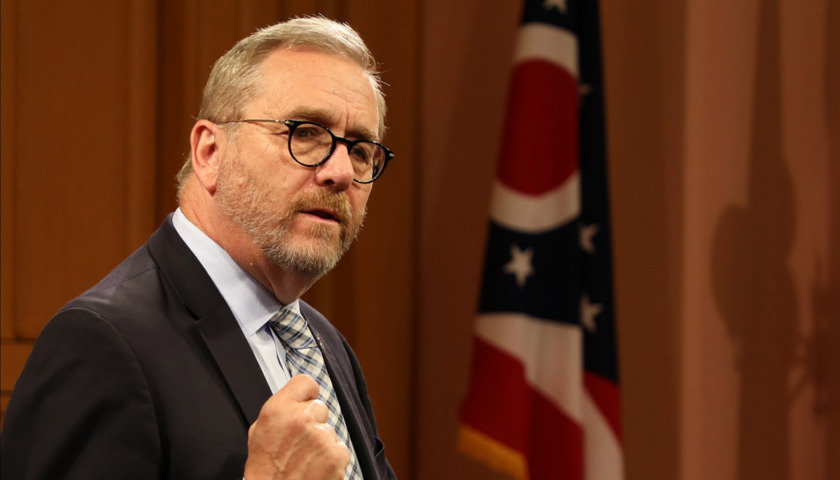Tennessee Republican Representative David Kustoff (R-TN-08) recently introduced a resolution in the House of Representatives that calls on Congress to create a strategy to address the rising violent crime in the United States. A similar resolution was also introduced in the U.S. Senate by Republican Senator Bill Cassidy (R-LA).
Read the full storyTag: epidemic
Roughly 40 Percent of Americans Say They Recently Suffered Financial Difficulties, Study Shows
Over 40% of U.S. households said they experienced severe financial hardship during the COVID-19 pandemic, citing difficulties paying bills, credit cards and draining their savings, according to a Harvard University report.
The survey conducted by the Harvard T.H.Chan School of Health, the Robert Wood Johnson Foundation, and the National Public Radio asked roughly 3,600 participants between July and August about problems they faced during the pandemic and how it affected their lives in recent months. Respondents were asked about financial, healthcare, education and personal safety concerns.
Roughly 30% of adults interviewed said they used up all or most of their savings during the pandemic, while 10% reported they had no savings before the pandemic began, according to the report. About one in five households had difficulties paying credit cards, loans, and other debts as well as utilities.
Read the full storyCommentary: House Democrats Want to Defund the Police (Again)
Word in Richmond is that the Virginia Senate — the more congenial of the two halves of the General Assembly — is looking to include the Virginia Republican idea that all law enforcement professionals should be extended a one-time $5,000 bonus.
House Democrats in the more rambunctious chamber are digging their heels in deep with a firm and potentially election hinging NO.
Read the full storyMichigan Could Get $800 Million from Opioid Settlement
Michigan could receive $800 million under a proposed multibillion-dollar national opioid settlement, Michigan Attorney General Dana Nessel said.
The settlement would involve Johnson & Johnson and the three largest pharmaceutical distributors in the country: Cardinal Health, McKesson, and AmerisourceBergen.
The historic agreement would resolve the claims of state and local governments nationwide and require industry changes.
Read the full story15 States Reach Agreement, Pave Way for $4.5 Billion Settlement over Opioid Crisis
A coalition of 15 states agreed to a deal with drug maker Purdue Pharma, which could soon lead to a $4.5 billion settlement over the company’s role in the U.S. opioid epidemic.
The states agreed to no longer oppose Purdue Pharma’s bankruptcy plan while the pharmaceutical company agreed to publicly release a trove of millions of documents, according to a court filing late Wednesday night. The Sackler family, which owns the company, would pay an additional $50 million under the settlement.
The agreement will be tacked onto a broader proposal that is set to be voted on by more than 3,000 plaintiffs, The New York Times reported. In addition to the states, plaintiffs include cities, counties and tribes that sued the company over its role in boosting its painkiller OxyContin, the cause of thousands of opioid deaths.
Read the full storyCommentary: Researchers Urge Americans to Focus on Loneliness Epidemic
As the pandemic recedes and Americans re-enter public life, the surgeon general and other public health experts are urging the country to focus on another national crisis, one that has lingered for decades and worsened in recent years: loneliness.
For many, pandemic-related lockdowns, social distancing, and physical isolation resulted in their most severe experiences of loneliness. Studies have shown that an uptick in loneliness and other mental health issues coincided with the pandemic, and that lockdown requirements almost certainly exacerbated pre-existing mental conditions. But for researchers who have studied loneliness, the recent increase is only one notable event in an extensive history.
Loneliness is not just a crisis in America, but also in Europe, Canada, Japan, China, Australia and, increasingly, South America and Africa. Loneliness also occurs regardless of race, class, culture, and religion. Even before the lockdowns, tens of millions of people throughout the world felt isolated.
Read the full storyTennessee State Rep. Rusty Grills on His No Mandatory Vaccines and Protecting Individual Liberties
Thursday morning on the Tennessee Star Report, host Michael Patrick Leahy welcomed Tennessee State Rep. (R) Rusty Grills to the newsmakers line to discuss his objectives before ending the Tennessee General Assembly’s current session and how he is committed to protecting the liberty of Tennesseans.
Read the full storyAG Yost Reaches Nearly $25 Million Settlement with McKinsey for Role in Ohio’s Opioid Crisis
Ohio Attorney General Dave Yost has agreed to a settlement of nearly $25 million in a case with McKinsey & Co. for the company’s role in fueling and profiting from the opioid crisis in the state.
Read the full storyCommentary: The Opioid Epidemic from a Rural Prosecutor’s Perspective
I was at the end of a meeting with a mother whose child is a victim of the country’s opioid epidemic. “So, I’m trying to write about how the opioid epidemic is affecting us,” I informed her. She responded immediately: “It touches everyone, it’s everywhere. I mean, how did it get to this?”
“Where do I even start?”
Read the full storyReport: Obama Administration Failed To Declare Fentanyl a National Emergency After Multiple Warnings
A groundbreaking report by the Washington Post has revealed that from 2013 to 2017, the Obama administration ignored, downplayed, or failed to act on multiple warnings that synthetic opioid deaths were becoming an epidemic in the country. In the most startling instance, 11 opioid medical experts pressed the administration to declare Fentanyl a national public health emergency in 2016. This would permit a “laserlike” focus that would greatly blunt the damage done to the nation. The administration reviewed their concerns and then decided not to act. According to the report: Between 2013 and 2017, more than 67,000 people died of synthetic-opioid-related overdoses — exceeding the number of U.S. military personnel killed during the Vietnam, Iraq and Afghanistan wars combined. The number of deaths, the vast majority from fentanyl, has risen sharply each year. In 2017, synthetic opioids were to blame for 28,869 out of the overall 47,600 opioid overdoses, a 46.4 percent increase over the previous year, when fentanyl became the leading cause of overdose deaths in America for the first time. Not until the final days of his administration did the White House finally declare fentanyl to be a national crisis, yet no legislation came as a result. Former Drug Czar,…
Read the full storyReport: One in Three Children Enter Foster Care Due to Parental Drug Abuse, Ohio Rate Jumped 29 Percent
A report released Tuesday by the nonprofit Child Trends revealed that for the sixth consecutive year, 2017 saw a significant rise in the number of children entering foster care due to parental drug abuse or drug seeking behavior. According to the report, 131 out of every 100,000 children in America ends up in foster care because one or both of their parents’ behavior in connection to drug use, representing a “5 percent increase from the previous fiscal year and a 53 percent increase since FY 2007.” The study ascertained the findings by combining statistics from several organizations and government agencies, most notably the National Data Archive on Child Abuse and Neglect (NDACAN), an initiative U.S. Department of Health and Human Services (HHS) and Cornell University. The HHS also provides their own statistics through the Children Bureau. Lastly, the Annie E. Casey Foundation, a privately funded nonprofit, also provides data on children and families throughout the country. In addition, the study also found that “six states and territories – Puerto Rico, Wyoming, New York, South Dakota, Wisconsin, and Ohio – saw the largest rate increases.” Of all fifty states, Puerto Rico, and the District of Columbia, 17 states and territories saw rate decreases, 3…
Read the full storyAn Ohio Medical Examiner Issued a Public Health Warning After Multiple Opioid Deaths Were Traced to Powerful Animal Sedatives
Dr. Thomas Gilson, the Cuyahoga County Medical Examiner, issued a Public Health Warning Thursday for the entire county. It stated that, after testing opioids seized at multiple crime scenes, the Cuyahoga County Regional Forensic Science Laboratory had discovered a “significant increase” in the presence of carfentanil, a synthetic opioid that is both extremely potent and deeply unsafe for use by humans. According to the Preliminary 2018 Drug Overdose Death Statistics, Cuyahoga County suffered “24 carfentanil-related deaths in 2018.” Though alarming, this is a “significant reduction from the 191 carfentanil-related deaths in 2017.” Carfentanil is the most potent opioid currently available for commercial use, and of the most potent ever developed. It is officially sold under the commercial title of Wildnil. The main use for the drug is sedating large animals, including “ungulates, elephants, and rhinoceros.” It is 10,000 times more potent than morphine and 100 times more powerful then fentanyl. “The re-appearance of carfentanil in the local illicit drug supply is alarming,” Gilson said. “This is a very lethal drug and anyone using illicit or diverted drugs needs to be aware of the possibility of being exposed to it…Having another person in the vicinity to call 911 and/or administer naloxone can be…
Read the full storyOpioid Abuse Estimated to Leave Over 20,000 Children in Foster Care by 2020
While the rampant opioid epidemic that has overtaken much of the country is finally getting the attention it deserves, some of the most vulnerable to its effects have been tragically overlooked. A startling report from the Public Children’s Services Association of Ohio estimates that, should current trends continue, over 20,000 children will be in foster care by 2020. From July 2017 to July 2018 alone, the total number of children entering foster care jumped from over 13,700 children to over 15,000. The main reason for this acceleration appears to be severe drug abuse throughout the state. In 2015, half of the children taken into foster care had come from families with some form of drug abuse. 28 percent were actively taking opioids when their children were removed. 67 percent of these children were under the age of 12 and over a quarter of them are three or younger. While the number of children in need continues to rise, support services are more strained than ever. The report also reveals that Ohio’s State Share for children services spending is currently dead last in the nation. Further, “even if the State’s Share…doubled, Ohio would still be 50th in the nation.” The majority of child…
Read the full story












